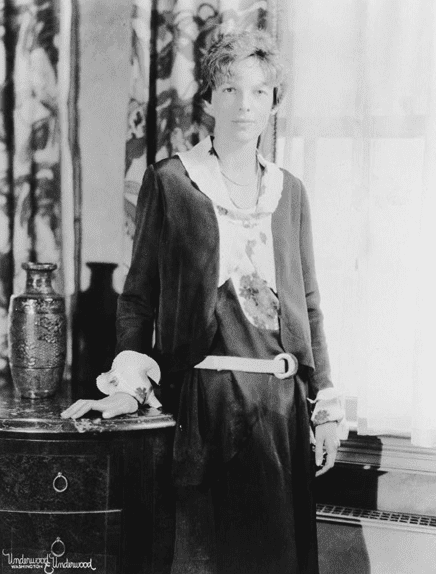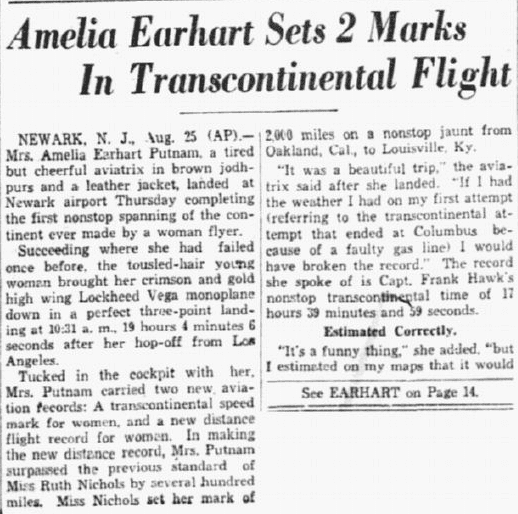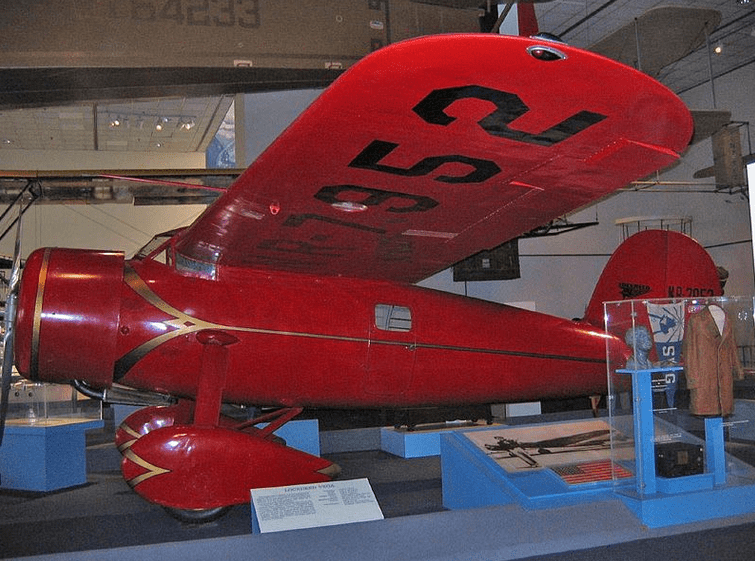In the 1920s and ’30s female pilot Amelia Earhart was an American heroine, with newspapers covering her every move and large, enthusiastic crowds awaiting her at each airport she landed after setting yet another record.

Early in her career she achieved an impressive first: on 16 May 1923 she became the first woman to receive a pilot’s license from the distinguished National Aeronautic Association. (It is true that 12 years earlier, Harriet Quimby scored her own historic achievement by becoming the first woman to earn a pilot’s license in the United States.) However, though Quimby was the earlier pioneer, Amelia Earhart is the woman aviator who captured the public’s attention.
In 1928 Earhart became the first woman to cross the Atlantic Ocean by airplane when she flew as part of the crew (her duty was to keep the flight log) with Wilmer Stultz and Louis Gordon.
That successful flight led to something even greater: four years later she became the first woman to fly across the Atlantic solo, in May 1932. This daring feat had only been accomplished once before, by Charles Lindbergh in 1927. Earhart’s accomplishment earned her a very high honor: she became the first woman to receive the Distinguished Flying Cross.
Exhilarated by her triumphant solo flight across the Atlantic Ocean, Earhart tackled another huge challenge: the first woman to fly nonstop across the United States. Her first attempt only reached Ohio, cut short by a faulty gas line. Undaunted, she tried again, taking off from Los Angeles, California, shortly after noon on 24 August 1932, and landing in Newark, New Jersey, 19 hours later on August 25 to an adoring reception from a large audience, many of them women. For this historic flight she wore the same outfit used in her trans-Atlantic flight (brown jodhpurs, a leather jacket, and a brown bandana) and flew the same crimson and gold Lockheed Vega monoplane.
These two newspaper articles show the excitement and admiration generated by Earhart’s solo transcontinental flight. The first is a news account of the feat itself; the second is an editorial praising her gallantry.

Here is a transcription of this article:
Amelia Earhart Sets 2 Marks in Transcontinental Flight
NEWARK, N.J., Aug. 25 (AP) – Mrs. Amelia Earhart Putnam, a tired but cheerful aviatrix in brown jodhpurs and a leather jacket, landed at Newark airport Thursday completing the first nonstop spanning of the continent ever made by a woman flyer.
Succeeding where she had failed once before, the tousled-hair young woman brought her crimson and gold high wing Lockheed Vega monoplane down in a perfect three-point landing at 10:31 a.m., 19 hours, 4 minutes 6 seconds after her hop-off from Los Angeles.
Tucked in the cockpit with her, Mrs. Putnam carried two new aviation records: A transcontinental speed mark for women, and a new distance flight record for women. In making the new distance record, Mrs. Putnam surpassed the previous standard of Miss Ruth Nichols by several hundred miles. Miss Nichols set her mark of 2,000 miles on a nonstop jaunt from Oakland, Cal., to Louisville, Ky.
“It was a beautiful trip,” the aviatrix said after she landed. “If I had the weather I had on my first attempt (referring to the transcontinental attempt that ended at Columbus because of a faulty gas line) I would have broken the record.” The record she spoke of is Capt. Frank Hawks’s nonstop transcontinental time of 17 hours 39 minutes and 59 seconds.
Estimated Correctly
“It’s a funny thing,” she added, “but I estimated on my maps that it would take me nineteen hours and fifteen minutes. I was almost correct.”
When the aviatrix stepped wearily from the cockpit of her ship after landing, an enthusiastic crowd, predominantly female, rushed out to greet her, and almost knocked her over.
“Don’t come near me. If you knew what I feel like – ”
She threw her hands up in a tired gesture. When photographers asked her to smile, she told them, “I don’t feel like smiling. I’m too tired.”
There was a broad smile on her face a moment later, however, as she asked the cameramen, “how’s this?”
Showers over Texas
Mrs. Putnam said she negotiated the first 1,000 miles of her trip at an average speed of 125 miles an hour. After passing over Texas, where thundershowers slowed her up, she found a tail wind that boosted her speed for the last 2,000 miles of the flight up to 160 miles an hour.
“I was so determined to get here,” she related, “that I skimped my gas. Otherwise I believe I would have broken the record. The last time on my unsuccessful trip, I flew a compass course; this time I followed the air lanes – which makes the trip about 100 miles longer – but I cut my corners a little bit.”
Mrs. Putnam skimped her gas by working the throttle gradually and keeping a moderate speed. More gasoline is consumed per mile at high speeds and the aviatrix decided to sacrifice speed to make certain her 460-gallon fuel supply would last until she reached Newark.
Flew at High Altitude
Explaining why she had not been sighted more frequently on her cross-country trip, Mrs. Putnam said, “I flew at 10,000 feet altitude most of the way.”
As she rode the air lanes, Mrs. Putnam had some “good old tomato juice.” She did not touch the vacuum bottle of cocoa or the sandwich she carried at her husband’s insistence. The vacuum bottle of water she carried became so hot in the pilot’s compartment that it was undrinkable, and the flyer’s first request on landing was, “water, please.”
George Putnam, the flyer’s husband, and her stepson, David Putnam, who flew from California to New York Monday, were not at the airport to meet her.
When someone asked the aviatrix what she intended to do next, she flashed her famous smile, and replied, “I am going to my home in Rye and rest.”
Here is a transcription of this article:
Our Amelia
It is fine to be a hero worshiper and perhaps it is even more agreeable to be a heroine worshiper, especially when the heroine is such a pleasant and human and unpriggish person as Amelia Earhart Putnam. She has done it again – smashed another record – flown alone and without pause across the continent from Los Angeles to Newark in less time than any other woman and in only an hour and a half more time than the men’s record. Our girl with the old-fashioned name and the keen smiling face and the tousled hair!
Unassuming and modest yet supremely self-confident, this slim, trim lady keeps on doing things in the air. Never a bit spoiled by adulation and always as bright as a new-minted dollar she is ideal hero material. Somehow it is hard to make one’s tongue say “Mrs. Putnam.” It is a good name, but of the earth earthy, and our Amelia is the hero girl of the clouds.
Note: An online collection of newspapers, such as GenealogyBank’s Historical Newspaper Archives, is not only a great way to learn about the lives of your ancestors – the old newspaper articles also help you understand American history and the times your ancestors lived in, and the news they talked about and read in their local papers. Did any of your ancestors get involved in the early days of aviation? Please share your stories with us in the comments section.
Related Articles:
